In many ways, the quality of the dish and the ease of cooking depends on the correct choice of the pan. Let's compare the 7 main types of pots and find out which type of pan can be called the most versatile and best.
7 types of pots - compare and lay out on the shelves
Enameled pan
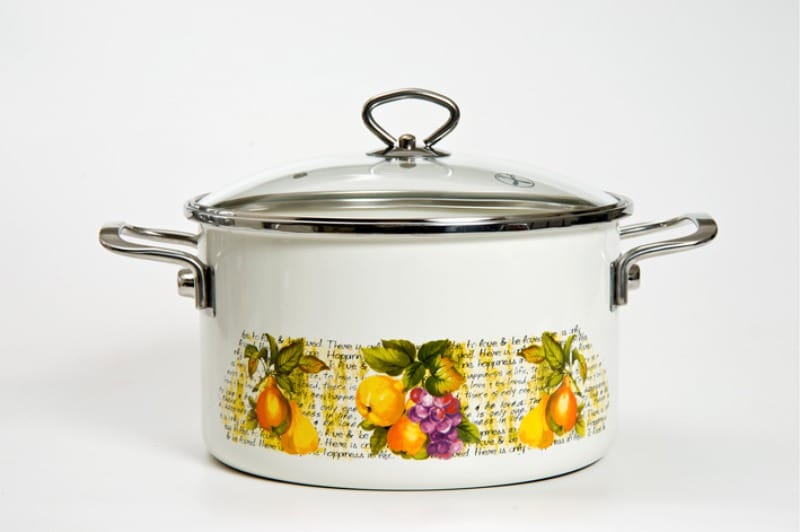
Pros: easy, beautiful, in it water quickly begins to boil. And in it you can store food in the refrigerator, as the enamel protects it from oxidation and the effects of metal salts.
Better fit for: cooking soups, stewed fruit, side dishes.
Minuses: enamel is a brittle coating, and therefore temporary and requiring careful handling. It can not be rubbed with abrasives and washed with acidic solutions, such as vinegar and citric acid, so as not to spoil the enamel.
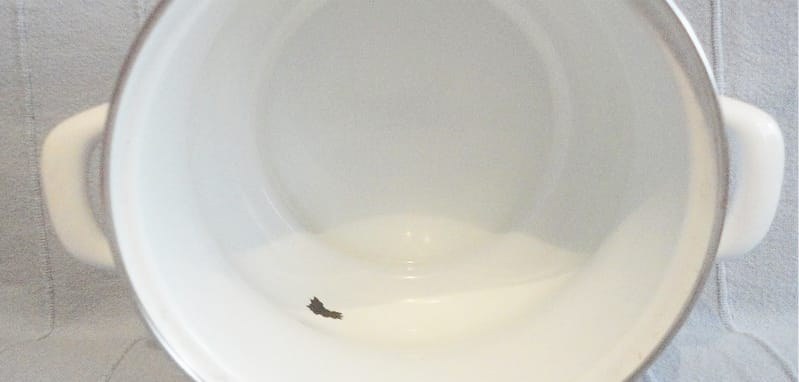
As soon as the enamel is rubbed or strayed as in the photo above, the dishes become unsuitable, since the exposed metal will begin to “give away” to the food unhealthy salt.
Bad for: cooking syrups and preserves.
How to choose an enamel pan: enameled pans can be enameled in two ways: by dipping or spraying. Today, many modern manufacturers apply enamel to the dishes by spraying, but this coating is thin and short-lived. Therefore, look for the Russian-made enameled pan, which is made by dipping technology. The method of applying the coating is easy to determine; it is only necessary to find dark dots on the outside of the dishes — these are the places to which the fasteners were installed in front of the enamel coating as shown in the photo below.
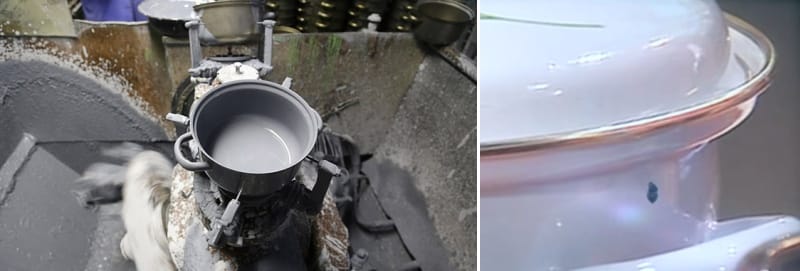
Another important point is the color of the enamel inside the pan. If from the outside it can be any, then only inside: black (but not brown), white, cream (but not yellow), gray-blue and blue. Enamel of any color is toxic. Also check the pan for the presence of chips and gaps on the walls and remember that the thicker the enamel, the longer it will last.
Aluminum pan without coating
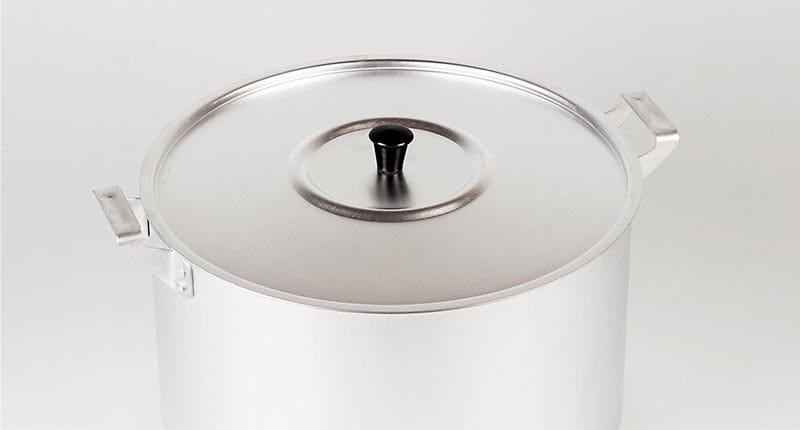
Pros: easy, cheap, heats up quickly.
Better fit for: boiling milk, boiling eggs, ravioli and pasta.
Minuses: easily deformed and darkens with time, aluminum dishes can change the taste of food due to the properties of aluminum to react with acids and alkalis, releases toxic metal salts in very small doses that accumulate in the body over time.
Bad for: cooking children's and dietary dishes, cooking complex dishes, such as pilau, as well as acidic foods.
How to choose an aluminum pan: Choose dishes with an even and thick bottom (more than 3 mm), thick walls (more than 1, 5 mm) and a tight lid. Also pay attention to the handles - they should not be welded, and bolted to the bolts as shown in the photo above.
Cast iron pan
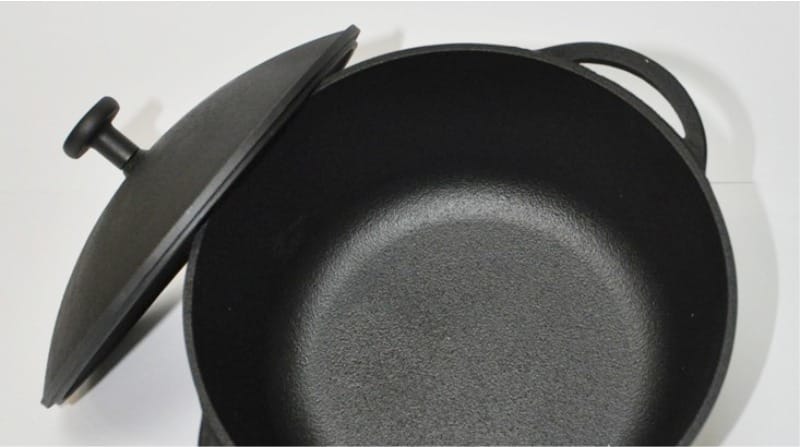
Pros: cast iron - durable, not afraid of scratches, safe and even good for health, as "gives" small doses of iron.Another advantage - cast iron has a natural "non-stick coating", which is formed from the oil, absorbed into the porous bottom of the cast iron. Pig-iron pan cools for a long time, and the dishes in it are the most delicious thanks to the same porosity.
Suitable: and for stewing, and for cooking, and for frying, and for baking dishes in the oven. Of course, pilaf and meat dishes are especially tasty in cast iron.
Minuses: cast iron pots are the most difficult, they can not be washed in dishwasherthey heat up for a long time, which increases the cooking time, it is also undesirable to store food in them and to leave water for a long time, since cast iron is prone to rust.
How to choose a cast iron pot: the darker, porous and heavier the cast iron, the better it is. A sign of poor-quality cast-iron cookware is the smoothness of the surface and relative lightness (a good cast-iron pan with a volume of 3 liters should weigh more than 4 kg).

Pan with non-stick teflon coating

Pros: Heats up quickly, and most importantly - practically does not require the use of oil.
Better fit for: cooking dietary meals.
Minuses: as soon as the Teflon coating is damaged, the dishes become unhealthy, as the food will be filled with carcinogenic toxic gases during cooking. Teflon coating even with careful use can last only 1 year.
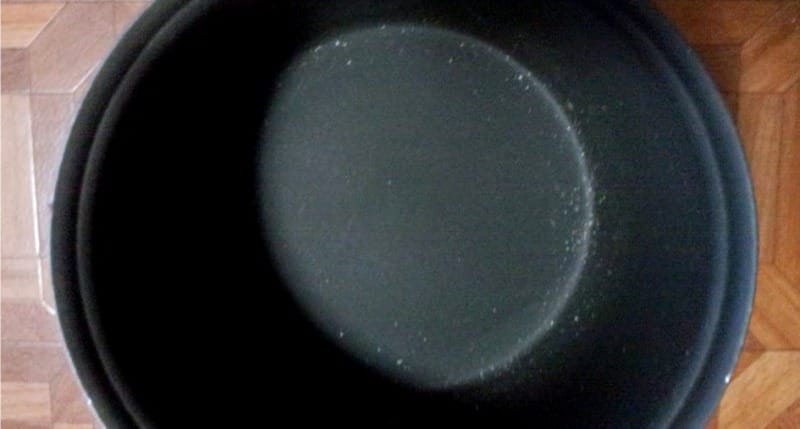
How to choose a pan with Teflon coating: the more multi-layered Teflon, the longer it will last. The number of layers is indicated on the package. Before buying dishes, make sure that the non-stick coating has a perfect smoothness (in the photo above, an example of how it should not be). Keep in mind that the choice of a stainless steel pan with a Teflon coating will not be justified, since such models are expensive, and serve not for long, because Teflon, even multi-layered, will sooner or later “peel off”.
Pot of heat-resistant / refractory ceramics
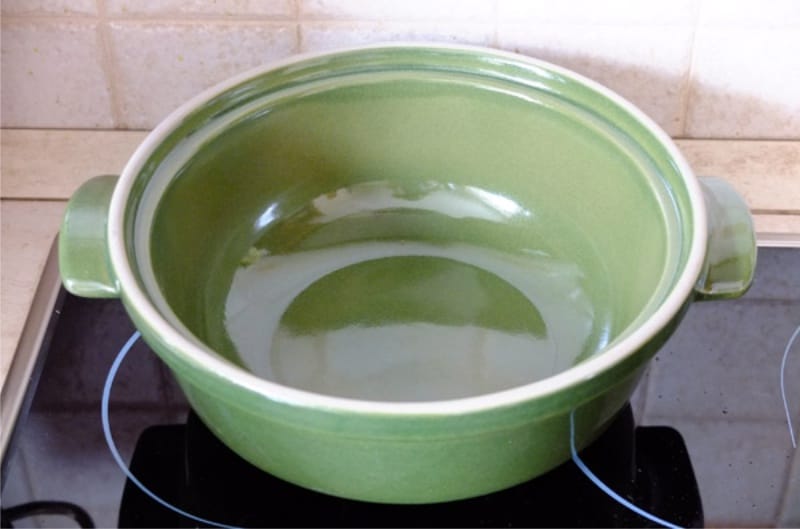
Pros: it is environmentally friendly and absolutely safe for health, and therefore it is good to keep food in the refrigerator in it, it also does not affect the taste of food, does not tend to burn (until the ceramics glaze is rubbed off) and keeps heat for a long time.
Better fit for: stewing vegetables, cooking stews and roasts, game, you can also bake dishes in the oven.
Minuses: require the use of a flame divider, heavier than aluminum pans and are more expensive. Ceramics can crack from falling, it is afraid of scratches from metal devices and washing with abrasives. As soon as the frosting on the bottom is wiped off, the food will start to burn, and the pan will absorb the fat, which complicates its cleaning. Remember that you can not immerse the ceramic pot in cold water immediately after cooking or put on the fire the dishes that you just took out of the refrigerator, because of the sudden temperature drop, it can crack or burst. Also, in order to avoid splitting the container, it is not allowed to boil water completely during the cooking process.
Tips for choosing: A good pan should have a bottom thickness of 4-7 mm and, accordingly, a large weight, for example, three-liter dishes should weigh more than 2 kg.
Refractory / heat resistant glass pan
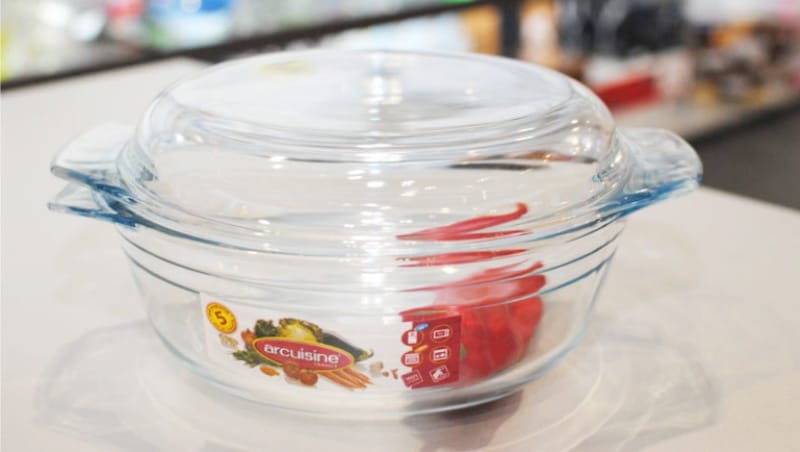
Pros: You can immediately put the glass pan on the table, as it looks pleasant, safe for health, not prone to burning, easy to clean and dishwasher safe, works well in baking dishes in the oven and storing dishes in the refrigerator, retains heat for a long time ;
Better fit for: cooking side dishes, soups, compotes, cereals.
Minuses: Do not put on a gas burner without a fire divider (photo below), may break from a fall and a sharp temperature drop.
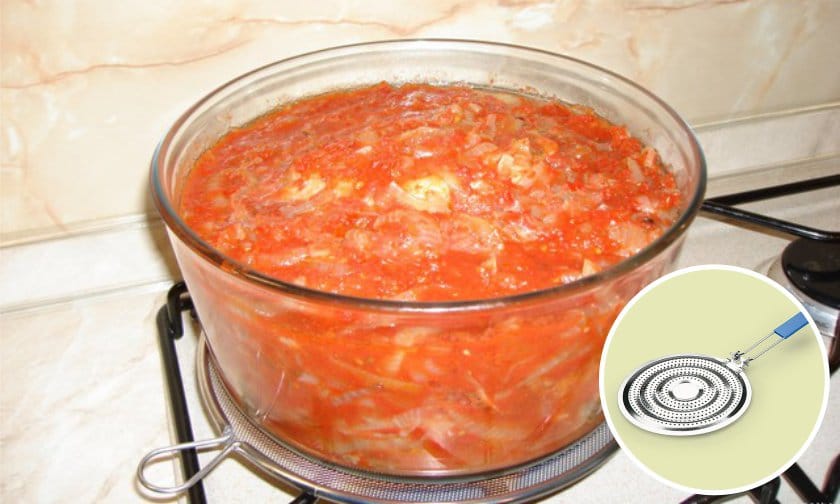
Bad for: stewing and frying.
Tips for choosing: Look at all the dishes in the light - the walls must be free of air bubbles, otherwise it may burst during cooking. It is important that the glass is not cloudy and opaque. The color of a good glass pan should have a bluish, turquoise hue.
Steel pan (stainless steel and medical steel)
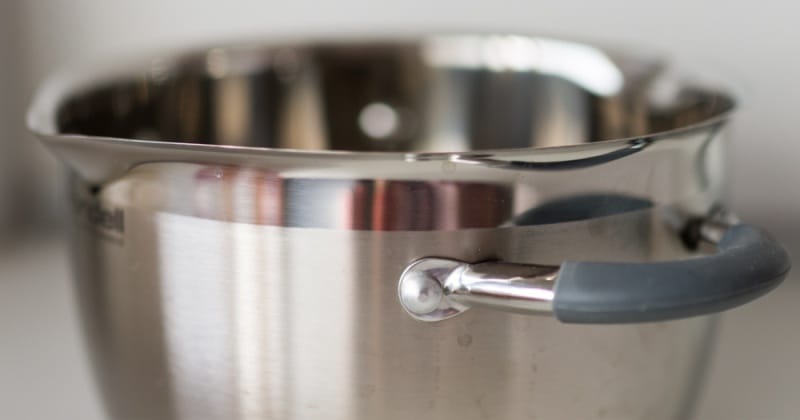
Pros: almost perfect kitchenware - stainless steel pots are impact resistant, wear-resistant, durable, not afraid of scratches from knives, forks and rims, evenly heated. Also, stainless steel pots are easy to clean - they can be cleaned with metal sponges and scrapers. Professional cooks most often cook it in stainless steel utensils.
Better fit for: universal, but more suitable for boiling and stewing than for frying food.
Minuses: A good thick-bottomed pot is expensive, it dims over time, indelible stains and stains appear on the bottom, it heats up more slowly than aluminum pans.
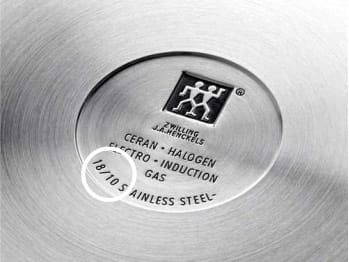
How to choose a stainless steel pot: Look for markings on the packaging or on the bottom of the dishes with the numbers: 18/10, 08/13, 12/13 or 12/18. The first digit is an indicator of chromium content in an alloy of stainless steel, and the second is nickel. The higher the first value, the better the dishes, respectively, the stainless steel with the marking 18/10 - the best, and this kind of alloy is called medical steel. The thicker the bottom and walls of dishes (the bottom is more than 3 mm, the walls are more than 0.5 mm thick), the more uniform the heating will be, and the food will not stick when frying and stewing dishes. Ideally, it is better to choose a pan with a double or triple bottom. But the marking declared by the manufacturer is not a guarantee of quality.
We offer to look at the next story “Test purchase” on how to choose the right stainless steel saucepan with a glass lid and how to recognize a fake, etc.
6 main recommendations
- Whatever material the dishes were made from, choosing from two models of the same type, choose one that has thicker walls and a bottom, as well as more layers of non-stick coating (if any);
- In a good pot, the handles must be screwed, not welded;
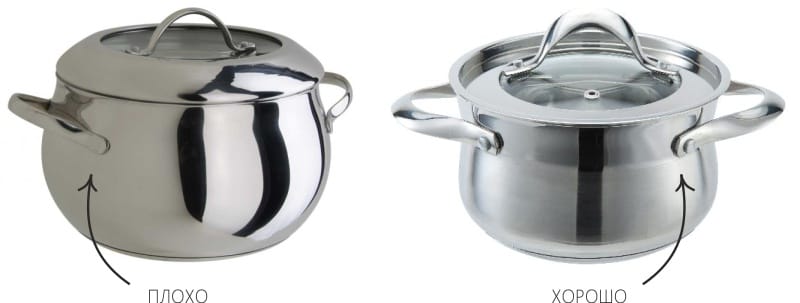
- Always check the dishes for defects;
- The lid should sit tight on the dishes and not fall when it is tilted;
- The bottom should be even and steady;
- It is better not to buy kitchen utensils as a whole ready-made set. Make a set of containers of different not only in size but also in type of material. For example, a cast iron cauldron is indispensable for cooking pilaf and meat dishes, a ceramic saucepan is useful for stewing vegetables, an enamel for cooking soups, get a teflon model for cooking diet meals, an aluminum small ladle will fit for quick cooking and, of course, do not forget to purchase a universal kitchenware utensils - stainless steel pan. It should be of the highest quality, because it is in it that you will most often cook. About the size of the dishes read below.
What volume of pans to choose?
What volume of pan is the best? Universal is considered a medium sized pot with a volume of 3 liters. In such a container, you can cook both soups, and side dishes, and meat, and compotes. But it is better to have a set of several pots of different sizes, shapes and types in the kitchen.
For cooking soups and compotes: the volume of pots for cooking soups and compotes is selected at the rate of 1 l per one family member. That is, for a small family of 3, it is quite enough to acquire 3-liter dishes. If you like to cook soups with a stock, then choose a larger pot.
For boiling eggs, vegetables, side dishes: 1-2 l small saucepan.
For cooking porridge for 1-2 servings and sauces: pots of less than 1 l.
- Guide to choosing a good universal pan
- Choosing dishes for glass-ceramic plates (standard and induction)
- How to clean the pan outside and inside - 8 simple ways for difficult cases
- Guide to the choice of a universal knife and "kitchen trio"
- How to sharpen a kitchen knife - 7 steps for beginners
- A guide to choosing a dryer for dishes



 (Rate the material! Already voted:214 average rating: 4,76 from 5)
(Rate the material! Already voted:214 average rating: 4,76 from 5)
On the photographs presented, the handles to the pots are not bolted, as the text says, but riveted (with rivets, not bolts)
The choice on the market is just great. Not like our parents had times. Truth to find quality is difficult, but possible. I, on the advice of my aunt, bought a Serotan metrotse pan in the Karusel shop. Quality and price pleased.
I did not notice a particular difference in the quality of enamel coating of metros from cheaper brands. Quite a lot of points inside.
Maybe you bought not the original? I once bought a Turkish market, dear, and you know she lived with me for 3 months. Treated too carefully.